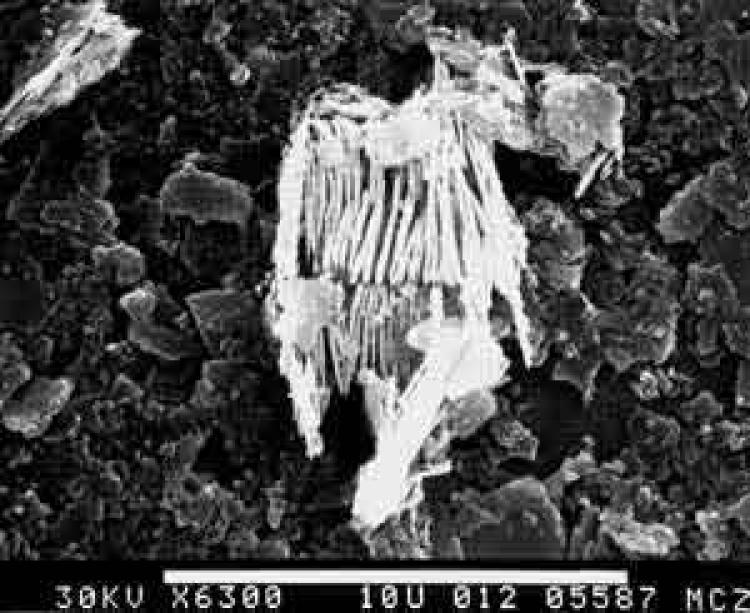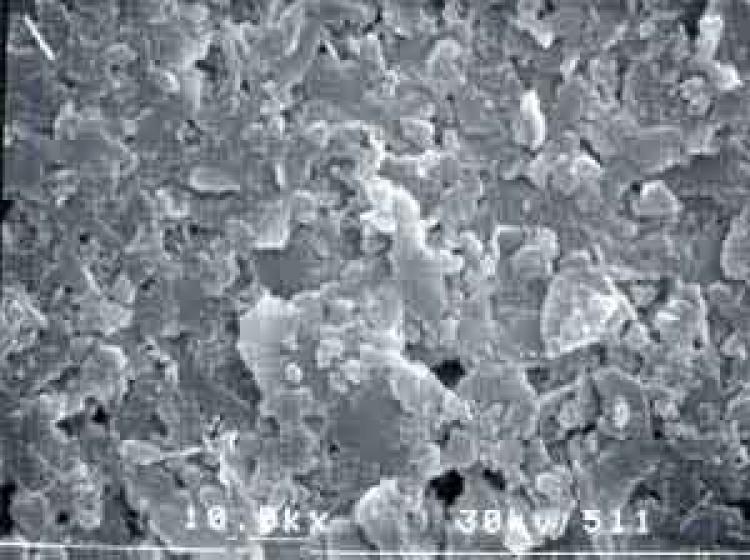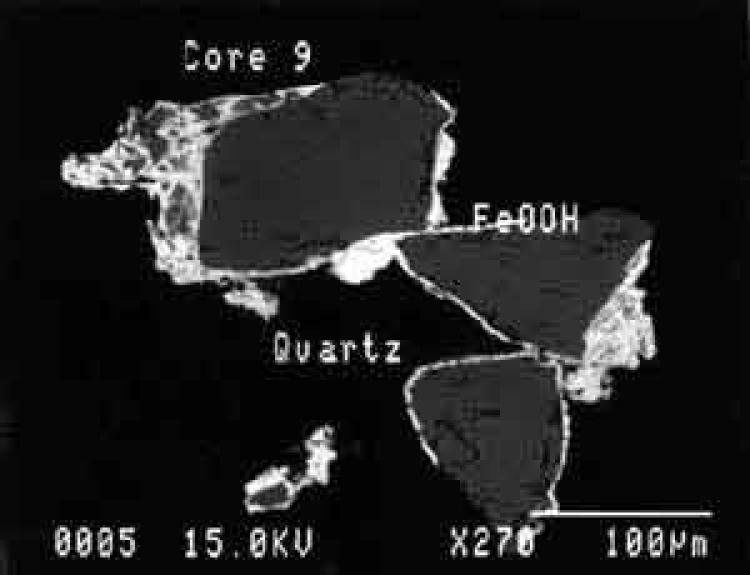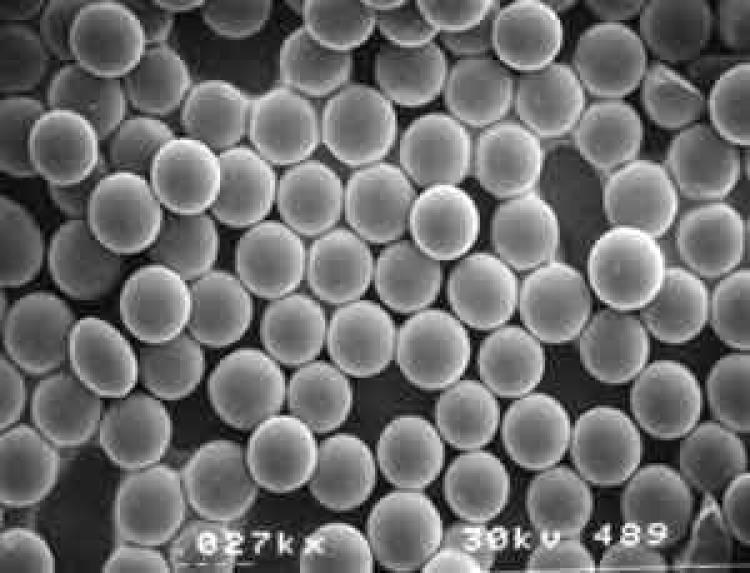Colloid Mobilization and Transport in Saturated Porous Media

"Booklet" of kaolinite -- colloids from Cohansey Sand in the New Jersey Pine Barrens. Magnification 6300x, scale bar 10 µm.
Overview
Over the past few years, our research group has been investigating some of the geochemical controls on the mobilization and transport of colloids in saturated porous media. Colloids have been implicated in the facilitated transport of some strongly-sorbed contaminants, like metals, radionuclides, and low-solubility organic compounds. We expect that colloid-facilitated transport of contaminants will be significant if (1) there is a source of colloids (mobilization), (2) contaminants bind extensively and essentially irreversibly to the colloids, and (3) colloids move with the groundwater (transport).
Projects
- Novel Approaches to Probing the Mechanism of Brownian Colloid Release from Packed Bed Surface
PI: Joe Ryan
NSF Research Initiation Award (CTS 9410301), 1994 to 1998 - The Advance of Colloid Mobilization and Transport Fronts: Intermediate-Scale Experiments
co-PIs: Joe Ryan and Menachem Elimelech (UCLA)
NSF Hydrologic Sciences (EAR 9418472), 1995 to 1998 - Colloid Mobilization and Transport in Contaminant Plumes: Field Experiments and Modeling
co-PIs: Joe Ryan and Menachem Elimelech (UCLA)
U.S. EPA, R.S. Kerr Lab (CR-824593), 1995 to 1997 - Colloids in Groundwater: Determining the Effects of Pumping Rate on the Suspension of Artifactual Colloids During Groundwater Sampling
PI: Joe Ryan
University of Colorado Grant-in-Aid, 1994
Collaborators
- Prof. Menachem Elimelech, Yale University, New Haven, Connecticut
- Dr. Subir Bhattacharjee, Yale University, New Haven, Connecticut

Mainly kaolinite colloids from the surficial aquifer below the Crane Wildlife Refuge, Cape Cod, Massachusetts. Magnification 10,000x, scale bar 1 µm.
Students and Theses
- Dean Abadzic, PhD in progress, Fundamental and Practical Investigations into the Mechanisms of Colloid Release in Saturated Porous Media. Dean's thesis investigates the release of colloids from surfaces in both highly controlled model systems of latex microspheres and glass surfaces to zeolite colloids in a permeable reactive barrier. Dean was funded primarily by the NSF Research Initiation Award.
- Rebecca Ard, MS, 1997, Natural and Artificial Colloid Mobilization in a Sewage-Contaminated Aquifer: Field and Laboratory Studies. Becky's thesis focused on the effect of altered solution chemistry (pH increase, ionic strength decrease, surfactant and reductant increase) on colloid mobilization (Ryan et al., 1999). Her field studies were conducted at the U.S. Geological Survey's field site on Cape Cod during the summer of 1996 with the help of Mike Bonewitz, an undergraduate, and Heather Reddy, a graduate student at the University of Virginia. Becky's research was funded by an EPA cooperative agreement with Dr. Robert Puls at he EPA's R.S. Kerr Lab in Ada, Oklahoma.
- Jonathan Loveland, PhD in progress, Role of Surfactants in Colloid Transport in Geochemically Heterogeneous Porous Media. Jon wrote his MS thesis on virus transport, then shifted over to colloids. His thesis will examine the role of geochemical heterogeneity in colloid deposition and release and the effects of surfactants on the extent and rate of colloid release. His porous medium is ferric oxyhydroxide-coated quartz sands that mimic the sands found in the Cape Cod glacial outwash aquifer used for our field studies.
- Robin Magelky, MS in progress, Effect of Chemical Perturbations on Colloid Deposition and Mobilization in a Sewage-Contaminated Ferric Oxyhydroxide-Coated Sand Aquifer. Robin's thesis represents an extension of some of the field work started by Rebecca Ard -- Robin went back into the field the next summer to perform more colloid deposition and mobilization experiments under altered chemical conditions. He was helped by Jenny Baeseman, an undergraduate from the University of Wisconsin-Stevens Point (now a PhD candidate in our department) and two of Meny Elimelech's graduate students at UCLA, Ning Sun and Chun-Han Ko. Robin also developed the technique to coat zirconium and titanium oxide particles with silica to better monitor colloid transport (Ryan et al., 2000).

Ferric oxyhydroxide-coated quartz grains from the Cape Cod, Massachusetts, aquifer. Electron microprobe, backscatter electrons. Magnification 270x, scale bar 100 µm.
Publications
(with links to PDF files; some PDF files are large -- 2-4 MBytes)
- Sun N., Elimelech M., Sun N.-Z., and Ryan J.N., 2001. Sensitivity analysis and parameter identifiability in colloid transport in geochemically heterogeneous porous media. Water Resources Research37, 209-222.
- Elimelech M., Nagai M., Ko C.-H., and Ryan J.N., 2000. The relative insignificance of mineral grain zeta potential to colloid transport in geochemically heterogeneous porous media. Environmental Science & Technology 34, 2143-2148.
- Ryan J.N., Elimelech M., Baeseman J.L., and Magelky R.D., 2000. Silica-coated titania and zirconia colloids for subsurface transport field experiments. Environmental Science & Technology 34, 2000-2005.
- Ryan J.N., Elimelech M., Ard R.A., Harvey R.W., and Johnson P.R., 1999. Bacteriophage PRD1 and silica colloid transport and recovery in an iron oxide-coated sand aquifer. Environmental Science & Technology33, 63-73.
- Ryan J.N. and Elimelech M., 1996. Colloid mobilization and transport in groundwater. Colloids and Surfaces A. Physicochemical and Engineering Aspects 107, 1-56.
- Ryan J.N. and Gschwend P.M., 1994. Effect of solution chemistry on the detachment of clay colloids from an iron oxide-coated sand. Environmental Science & Technology 28, 1717-1726.
- Ryan J.N. and Gschwend P.M., 1994. Effect of ionic strength and flow rate on colloid detachment kinetics: Dependence on intersurface potential energy. Journal of Colloid and Interface Science 164, 21-34.
- Ryan J.N. and Gschwend P.M., 1992. Effect of iron diagenesis on the transport of clay colloids in an unconfined sand aquifer. Geochimica et Cosmochimica Acta 56, 1507-1522.
- Ryan J.N. and Gschwend P.M., 1990. Groundwater colloids in two Atlantic Coastal Plain aquifers: Field studies. Water Resources Research26, 307-322.

Amorphous silica (glass) beads used in model particle deposition and release studies. Magnification 27x, scale bar 100 µm.
Presentations
- Abadzic S.D. and Ryan J.N., Effect of colloid release on permeability reduction in a zeolite porous medium. Abstracts of Papers of the American Chemical Society, in press. Presented at the 220th National Meeting of the American Chemical Society, Environmental Chemistry Division, August 2000.
- Abadzic S.D. and Ryan J.N., Particle release and permeability reduction in a natural zeolite (clinoptilolite), a permeable reactive barrier candidate material (poster). Presented at the Gordon Research Conference for Environmental Science: Water, Holderness School, Plymouth, New Hampshire, June 2000.
- Loveland J.P., Ryan J.N., and Elimelech M., Anionic surfactant adsorption and silica-coated colloid release in a geochemically heterogeneous porous media. Presented at the 74th Colloid and Surface Symposium of the American Chemical Society, Bethlehem, Pennsylvania, June 2000.
- Ryan J.N., Elimelech M., Ard R.A., and Magelky M.D., 1999. Mobilization and transport of natural and synthetic colloids and a virus in an iron oxide-coated sewage-contaminated aquifer. Presented at the U.S. Geological Survey Toxic Substances Hydrology Technical Meeting, Charleston, South Carolina, March, 1999.
- Loveland J.P. and Ryan J.N., 1999. Surfactant-induced colloid release from mineral surfaces: The significance of surfactant type and concentration on release behavior. Abstracts of Papers of the American Chemical Society 217, U731, Part 1. Presented at the 217th National Meeting of the American Chemical Society, Environmental Chemistry Division, March 1999.
- Ryan J.N., Elimelech M., and Magelky R.D., 1999. Silica-coated titania (TiO2) and zirconia (ZrO2) particles for particle transport field experiments. Abstracts of Papers of the American Chemical Society 217, U776, Part 1. Presented at the 217th National Meeting of the American Chemical Society, Environmental Chemistry Division, March 1999.
- Ryan J.N., Harvey R.W., Metge D.W., and Larson J.E., 1997. Transport of bacteriophage PRD1 and silica colloids in a sewage-contaminated aquifer. Eos, Transactions of the American Geophysical Union 86, F231. Presented at the Fall Meeting of the American Geophysical Union, December 1997.
- Abadzic D.S. and Ryan J.N., 1996. Particle size effect in the release of deposited Brownian colloids. Presented at the 70th Colloid and Surface Science Symposium, American Chemical Society, Potsdam, New York, June 1996.
- Ryan J.N., Loveland J.P., Amy G.L., and Harvey R.W., 1993. Effect of (bio)colloid size on the kinetics of detachment from packed bed surfaces. Eos, Transactions of the American Geophysical Union 74, 132. Presented at the Spring Meeting of the American Geophysical Union, May 1993.
- Ryan J.N. and Gschwend P.M., 1992. Effect of solution chemistry on the detachment of clay colloids from an iron oxide-coated sand. Eos, Transactions of the American Geophysical Union 73, 162. Presented at the Fall Meeting of the American Geophysical Union, December 1992.
- Ryan J.N. and Gschwend P.M., 1990. Colloid mobilization in an iron oxide-coated aquifer. Eos, Transactions of the American Geophysical Union 71, 503-504. Presented at the Spring Meeting of the American Geophysical Union, May 1990.
- Ryan J.N. and Gschwend P.M., 1988. The mobilization of colloids in anoxic groundwater. International Conference on Advances in Ground-Water Hydrology, American Institute of Hydrology, November 1988.

